AUTUMN’S LUSHNESS
Preparation
How green is your vegetable garden? Mine is very. Summer long gone and frost in the air doesn’t have to bring on a scene of browned and ragged leaves clinging to withered stems.
My garden is green, having arrived at its present state of enthusiasm by, first, my keeping one step ahead of weeds. Especially after midsummer, some gardeners relax their grips on weed control, letting heat loving annuals like lamb’s-quarters, purslane, and pigweed take hold. And then cooler weather brings quackgrass and creeping charlie stealthily trying to . . . well, creep . . . in at the garden’s edges.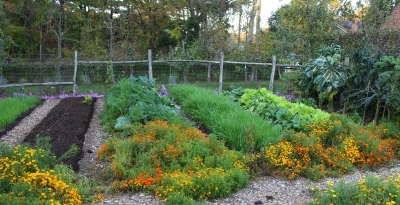
Regular weeding forays through summer and early fall took but a few minutes of my time — much less than the heroic effort firmly established weeds would have required. I supplemented regular hand weeding with spraying an organic herbicide in paths and with hoeing. Hoeing with either my winged weeder or wire weeder was for places where many small weeds had sprung up and the soil surface was dry and viable.
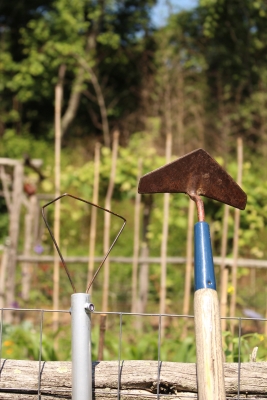
Planning
So much for removing interlopers. As Shakespeare might have said (but didn’t): Lack of weeds doth not a good garden make. It was season-long, carefully chosen plantings that have provided that palette of lush greenery itself.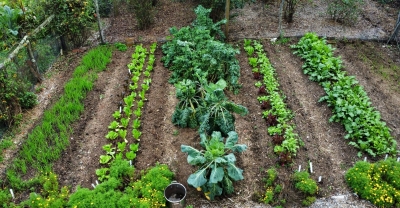
I started planting for the present way back in early spring. That was when I sowed kale seeds, which yielded tasty leaves beginning in early summer and continued and will continue to do so for weeks, perhaps months, to come. Brussels sprouts were also sown back then for harvest that would have begun soon, but not this year. Crop failure. Healthy plants but no sprouts on them! (Possibly from too much shading of stalks from early cabbages flanking the Brussels sprouts.)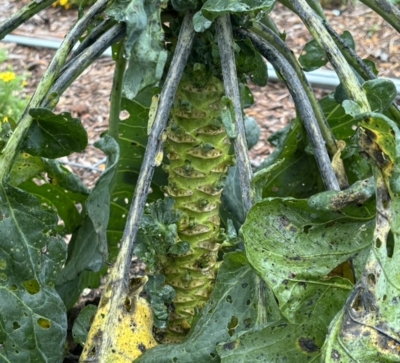
If you had stopped by my garden in late spring, you would have caught me sowing seeds of fall cabbage. It was odd to be planting these same vegetables while growth of early spring sown cabbages was well under way.
Moving on into high summer summer, I planted seeds of Batavian endive, a bed of which now stands out in the vegetable garden like a frothing sea of greenery. I dressed it up with interplanted red lettuce, whose leaves will be in salad bowls and out of the way by the time endive leaves are ready to reach out to “hold hands” with their endive neighbors along the row.
Through summer I continued planting, selecting to grow those vegetables that would enjoy the present crisp weather, then sowing their seeds according to the number of days they would take to mature. So turnips went in late August, then small radishes a couple of weeks later. (I write about and have tables for sowing and planting dates for individual vegetables in my book Weedless Gardening, available from the usual sources and here.)
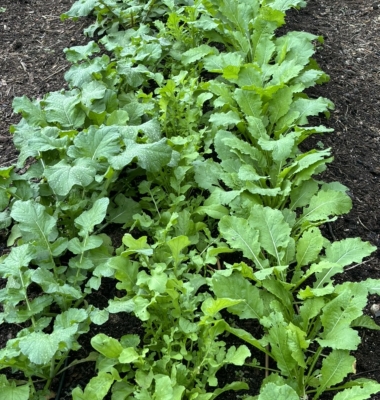
Watermelon radish, arugula, Hakurei turnips
Chinese cabbages, both napa type and bok choy are now contributing to my garden’s vibrancy, except for Red Dragon Chinese cabbage, which has ominous, purplish-red leaves.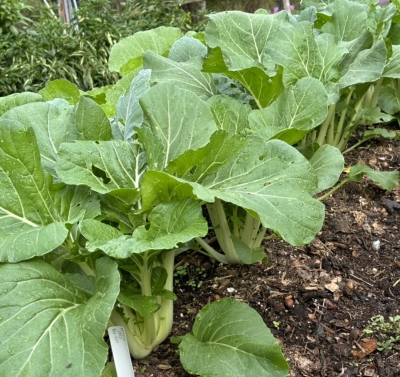
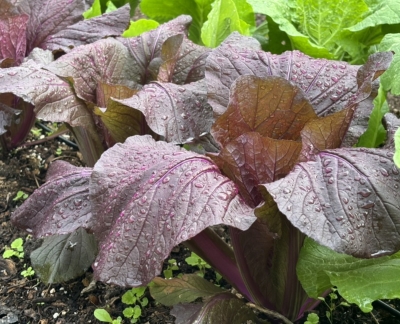
Bok Choy, Red Dragon
Visuals
My last planting of the season, in various beds up to the end September, was for lushness not for eating. That planting was of cover crops, which are plants grown solely for the benefit of the soil. The cover crop that I chose to plant was oats. In past years I’ve sometimes sown barley, or peas in conjunction with with either oats or barley.
I sowed these plants in any beds that were cleared of summer crops — beans or corn, for example — by September 30th and were not slated to receive any of the aforementioned fall vegetables. Around here, later sowings don’t have enough heat and, especially light, to make good growth.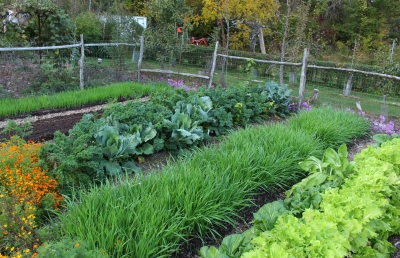
Now, at about eight inches high and still growing, the oats will keep rain from washing away soil or leaching out nutrients, and enrich the ground with valuable organic matter. After frigid weather kills these plants in January or February, their rotting roots will leave behind channels for water and air. Winter kill of these plants fits in well with my not ever tilling the beds. In spring, I just rake the dead oat leaves — no longer connected to their also dead roots — off the beds, and plant.
The cover crop should also shade out any weeds trying to get a foothold. Should, but don’t, in my garden. Here, come spring, henbit seems especially at home in those beds. Perhaps they are able to sneak in because they’re hidden by the oats. Perhaps . . . ?
No matter. A dense stand of cover crops, like the rest of the greenery, simply looks prettier than bare soil and decrepit plants.



What should I be doing with my very large fig tree that is in a big pot outside. I bring it into the garage for the winter but wonder when that should be. Advice please?
Thank you.
Depends on where you are. Here in Zone 5, I bring my potted plants in around mid December.
Lee, do deer like fig leaves? My garden was looking lush and green until the deer got in and decimated everything! My fig tree is still untouched, but I’m concerned that now the deer have eaten everything else—including much of my cover crop of peas and clover-they will come back for my fig tree. It’s really too big to move inside every night, so should I protect it with something? Thanks for the pictures of your glorious garden!
Most animals generally don’t like to eat fig leaves, probably because of the irritating white sap broken tissue bleeds. Then again, I once suggested to a friend that it was ok to plant garlic outside a garden because deer wouldn’t eat it. They did. It depends on how hungry a deer is. By the way peas,, clover, and other legumes are among their favorite foods.
What inspiration – I don’t know what happened to me this fall but I certainly loosened my grip on weed control! your eloquent words sound much better that “I got lazy” – even after gifting myself a new AM Leonard stirrup hoe! you certainly make me want to do better!
I planted some arugula, mustard greens and fennel according to the time required between sow date and first frost time. During the height of late summer, they somewhat sprouted but was going no way. They are all flourishing now and I will have plenty of cooler crops to enjoy until hard freeze. I had wanted to sow some winter cover crop but my summer crops were still producing… May be I should tried to sow around their foliage next year and see what will happen.
Yes, that can work. Just water enough to get the cover crop seeds going and don’t sow too early for them to compete heavily with the summer crops.